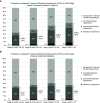Prevalence of Apparent Treatment-Resistant Hypertension in Chronic Kidney Disease in Two Large US Health Care Systems
- PMID: 36400564
- PMCID: PMC9528269
- DOI: 10.2215/CJN.04110422
Prevalence of Apparent Treatment-Resistant Hypertension in Chronic Kidney Disease in Two Large US Health Care Systems
Abstract
Background and objectives: More intensive BP goals have been recommended for patients with CKD. We estimated the prevalence of apparent treatment-resistant hypertension among patients with CKD according to the 2017 American College of Cardiology/American Heart Association (ACC/AHA; BP goal <130/80 mm Hg) and 2021 Kidney Disease Improving Global Outcomes (KDIGO; systolic BP <120 mm Hg) guidelines in two US health care systems.
Design, setting, participants, & measurements: We included adults with CKD (an eGFR <60 ml/min per 1.73 m2) and treated hypertension from Kaiser Permanente Southern California and the Veterans Health Administration. Using electronic health records, we identified apparent treatment-resistant hypertension on the basis of (1) BP above the goal while prescribed three or more classes of antihypertensive medications or (2) prescribed four or more classes of antihypertensive medications regardless of BP. In a sensitivity analysis, we required diuretic use to be classified as apparent treatment-resistant hypertension. We estimated the prevalence of apparent treatment-resistant hypertension per clinical guideline and by CKD stage.
Results: Among 44,543 Kaiser Permanente Southern California and 241,465 Veterans Health Administration patients with CKD and treated hypertension, the prevalence rates of apparent treatment-resistant hypertension were 39% (Kaiser Permanente Southern California) and 35% (Veterans Health Administration) per the 2017 ACC/AHA guideline and 48% (Kaiser Permanente Southern California) and 55% (Veterans Health Administration) per the 2021 KDIGO guideline. By requiring a diuretic as a criterion for apparent treatment-resistant hypertension, the prevalence rates of apparent treatment-resistant hypertension were lowered to 31% (Kaiser Permanente Southern California) and 23% (Veterans Health Administration) per the 2017 ACC/AHA guideline. The prevalence rates of apparent treatment-resistant hypertension were progressively higher at more advanced stages of CKD (34%/33%, 42%/36%, 52%/41%, and 60%/37% for Kaiser Permanente Southern California/Veterans Health Administration eGFR 45-59, 30-44, 15-29, and <15 ml/min per 1.73 m2, respectively) per the 2017 ACC/AHA guideline.
Conclusions: Depending on the CKD stage, up to a half of patients with CKD met apparent treatment-resistant hypertension criteria.
Keywords: chronic kidney disease; delivery of health care; hypertension; prevalence.
Copyright © 2022 by the American Society of Nephrology.
Figures



Comment in
-
Resistant Hypertension in Chronic Kidney Disease: A Burden unto Itself.Clin J Am Soc Nephrol. 2022 Oct;17(10):1436-1438. doi: 10.2215/CJN.09720822. Epub 2022 Sep 9. Clin J Am Soc Nephrol. 2022. PMID: 36400566 Free PMC article. No abstract available.
Similar articles
-
Representation of Real-World Adults With Chronic Kidney Disease in Clinical Trials Supporting Blood Pressure Treatment Targets.J Am Heart Assoc. 2024 Apr 2;13(7):e031742. doi: 10.1161/JAHA.123.031742. Epub 2024 Mar 27. J Am Heart Assoc. 2024. PMID: 38533947 Free PMC article.
-
Apparent treatment-resistant hypertension: characteristics and prevalence in a real-world environment of an integrated health system.J Hypertens. 2020 Aug;38(8):1603-1611. doi: 10.1097/HJH.0000000000002419. J Hypertens. 2020. PMID: 32251197
-
Potential US Population Impact of the 2017 ACC/AHA High Blood Pressure Guideline.Circulation. 2018 Jan 9;137(2):109-118. doi: 10.1161/CIRCULATIONAHA.117.032582. Epub 2017 Nov 13. Circulation. 2018. PMID: 29133599 Free PMC article.
-
KDOQI US Commentary on the 2017 ACC/AHA Hypertension Guideline.Am J Kidney Dis. 2019 Apr;73(4):437-458. doi: 10.1053/j.ajkd.2019.01.007. Am J Kidney Dis. 2019. PMID: 30905361 Free PMC article. Review.
-
Is the KDIGO Systolic Blood Pressure Target <120 mm Hg for Chronic Kidney Disease Appropriate in Routine Clinical Practice?Hypertension. 2022 Jan;79(1):4-11. doi: 10.1161/HYPERTENSIONAHA.121.18434. Epub 2021 Nov 17. Hypertension. 2022. PMID: 34784720 Free PMC article. Review.
Cited by
-
Revisiting resistant hypertension in kidney disease.Curr Opin Nephrol Hypertens. 2024 Sep 1;33(5):465-473. doi: 10.1097/MNH.0000000000001002. Epub 2024 May 10. Curr Opin Nephrol Hypertens. 2024. PMID: 38726750 Free PMC article. Review.
-
Hyperaldosteronism Screening and Findings From a Large Diverse Population With Resistant Hypertension Within an Integrated Health System.Perm J. 2024 Mar 15;28(1):3-13. doi: 10.7812/TPP/23.096. Epub 2023 Nov 27. Perm J. 2024. PMID: 38009955 Free PMC article.
-
Apparently Resistant Hypertension in Polish Hemodialyzed Population: Prevalence and Risk Factors.J Clin Med. 2023 Aug 20;12(16):5407. doi: 10.3390/jcm12165407. J Clin Med. 2023. PMID: 37629449 Free PMC article.
-
Resistant Hypertension in Chronic Kidney Disease: A Burden unto Itself.Clin J Am Soc Nephrol. 2022 Oct;17(10):1436-1438. doi: 10.2215/CJN.09720822. Epub 2022 Sep 9. Clin J Am Soc Nephrol. 2022. PMID: 36400566 Free PMC article. No abstract available.
-
Correlational Analysis of Resistant Hypertension with Diabetes Mellitus, Chronic Kidney Disease, and the Interplay of Sodium, Calcium, Magnesium, and Phosphorus.Vasc Health Risk Manag. 2025 Apr 7;21:217-228. doi: 10.2147/VHRM.S504454. eCollection 2025. Vasc Health Risk Manag. 2025. PMID: 40224136 Free PMC article.
References
-
- Thomas G, Xie D, Chen HY, Anderson AH, Appel LJ, Bodana S, Brecklin CS, Drawz P, Flack JM, Miller ER 3rd, Steigerwalt SP, Townsend RR, Weir MR, Wright JT Jr, Rahman M; CRIC Study Investigators : Prevalence and prognostic significance of apparent treatment resistant hypertension in chronic kidney disease: Report from the Chronic Renal Insufficiency Cohort study. Hypertension 67: 387–396, 2016. 10.1161/HYPERTENSIONAHA.115.06487 - DOI - PMC - PubMed
-
- Akwo EA, Robinson-Cohen C, Chung CP, Shah SC, Brown NJ, Ikizler TA, Wilson OD, Rowan BX, Shuey MM, Siew ED, Luther JM, Giri A, Hellwege JN, Velez Edwards DR, Roumie CL, Tao R, Tsao PS, Gaziano JM, Wilson PWF, O’Donnell CJ, Edwards TL, Kovesdy CP, Hung AM; VA Million Veteran Program : Association of apparent treatment-resistant hypertension with differential risk of end-stage kidney disease across racial groups in the Million Veteran Program. Hypertension 78: 376–386, 2021. 10.1161/HYPERTENSIONAHA.120.16181 - DOI - PMC - PubMed
MeSH terms
Substances
Grants and funding
LinkOut - more resources
Full Text Sources
Medical
Research Materials
Miscellaneous

